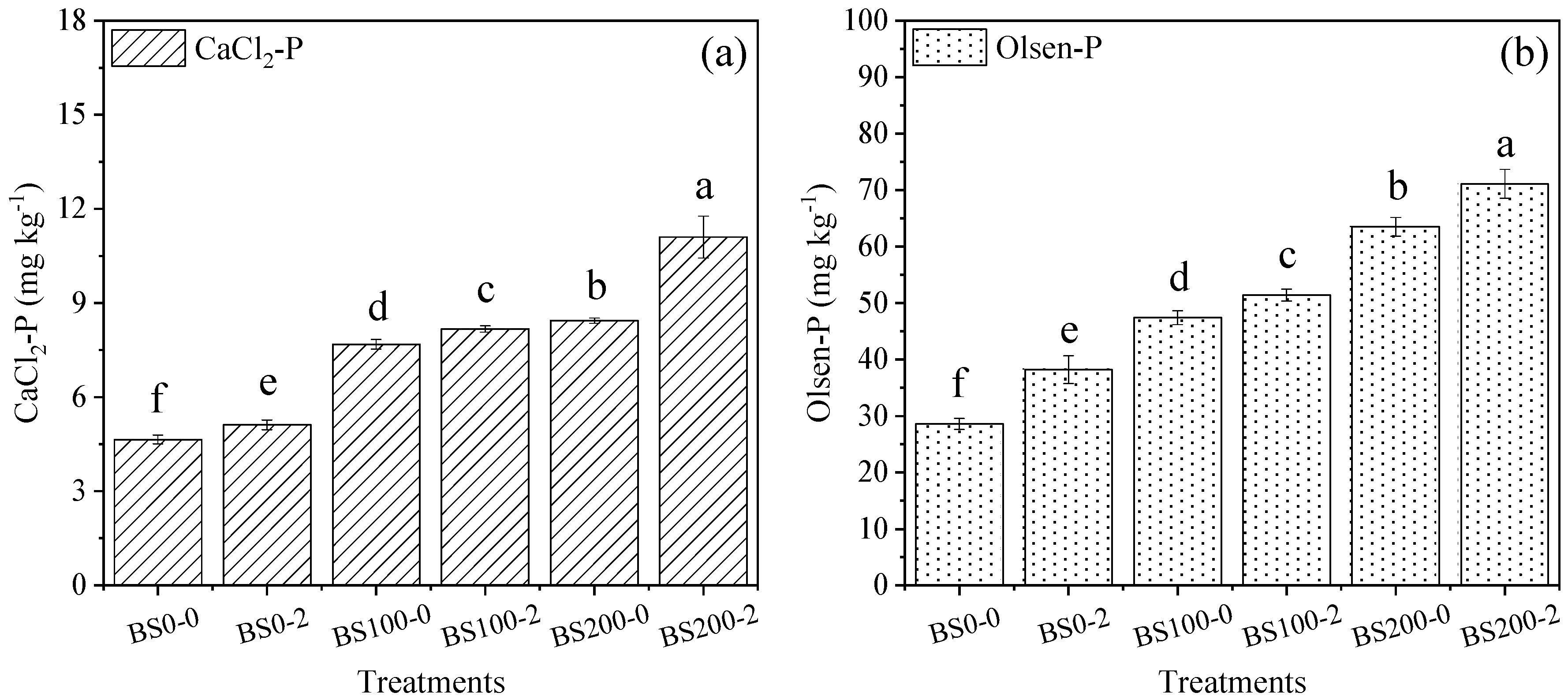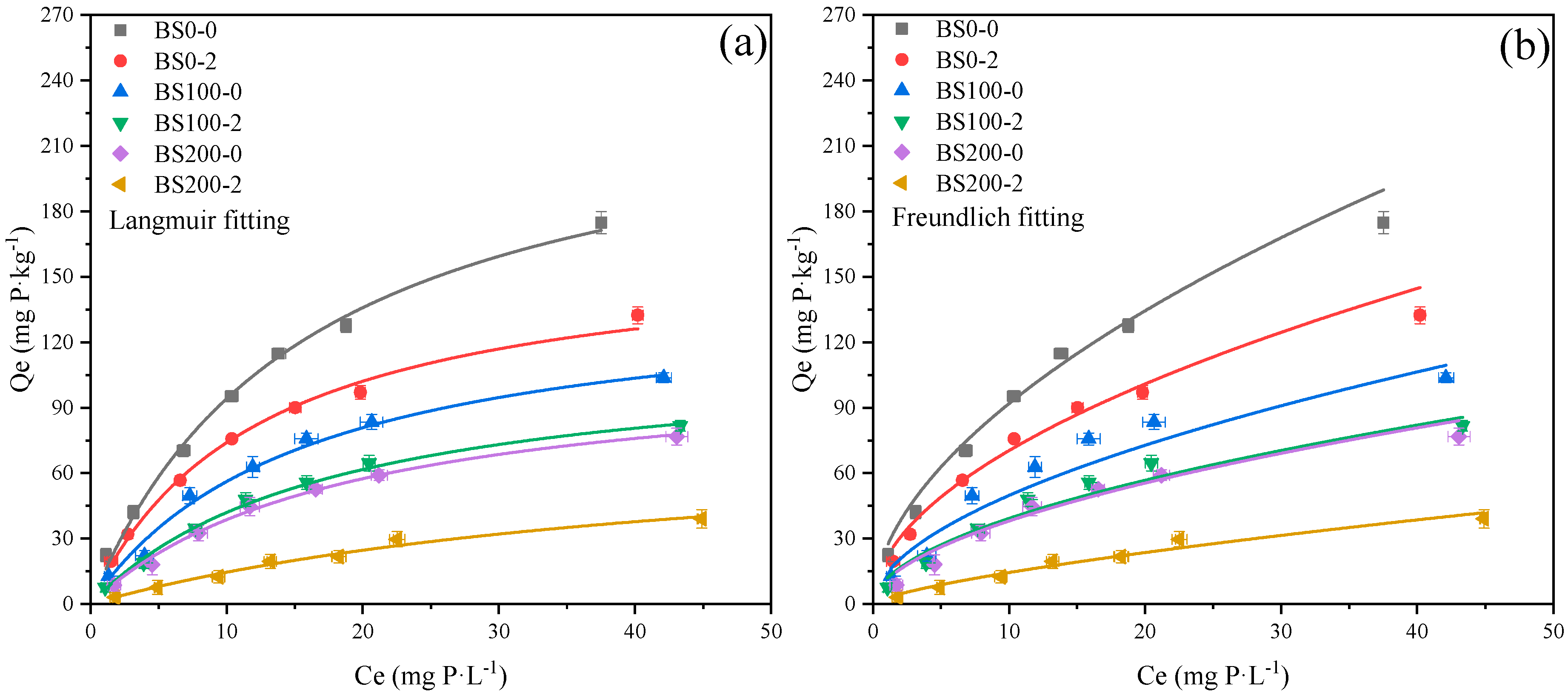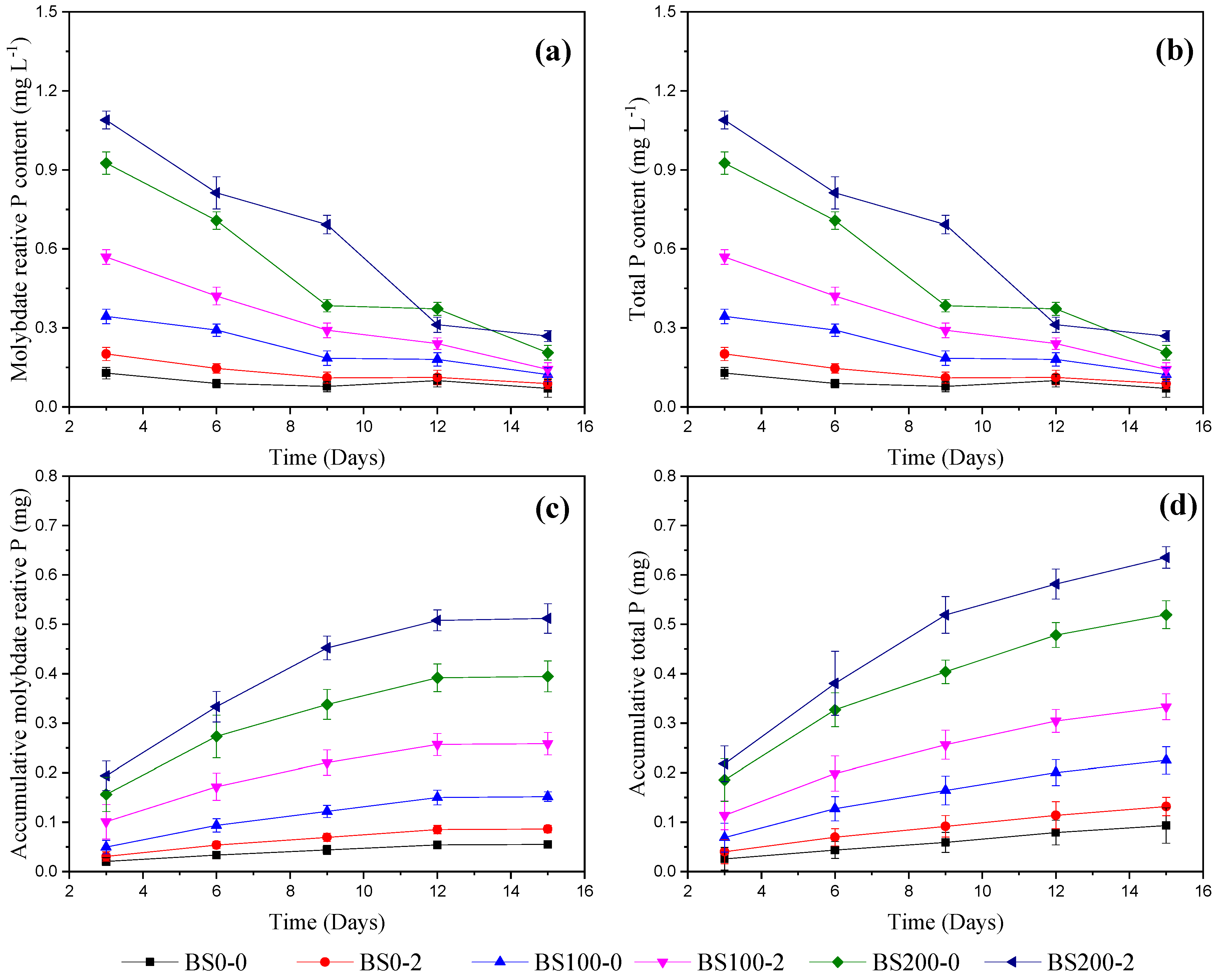Effects of Combined Applications of Biogas Slurry and Biochar on Phosphorus Leaching and Fractionations in Lateritic Soil
Abstract
:1. Introduction
2. Materials and Methods
2.1. Soil, Biochar, and Biogas Slurry Samples
2.2. Experiment Design
2.3. Analysis of Incubated Soil and Leachate
2.4. P Adsorption in Soils or Soil–Biochar
2.5. Statistical Analysis
3. Results and Discussion
3.1. Soil Labile P, P Fractionation, and Soil pH Changes
3.2. P Adsorption on Biochar and Biogas-Slurry-Amended Soils
3.3. Effects of Biochar and Biogas Slurry on Soil P-Leaching
4. Conclusions
Author Contributions
Funding
Institutional Review Board Statement
Informed Consent Statement
Data Availability Statement
Acknowledgments
Conflicts of Interest
References
- Peng, Y.; Sun, Y.; Fan, B.; Zhang, S.; Bolan, N.S.; Chen, Q.; Tsang, D.C. Fe/Al (hydr) oxides engineered biochar for reducing phosphorus leaching from a fertile calcareous soil. J. Clean. Prod. 2021, 279, 123877. [Google Scholar] [CrossRef]
- Chen, S.; Zhang, S.; Yan, Z.; Peng, Y.; Chen, Q. Differences in main processes to transform phosphorus influenced by ammonium nitrogen in flooded intensive agricultural and steppe soils. Chemosphere 2019, 226, 192–200. [Google Scholar] [CrossRef] [PubMed]
- Zhang, B.; Fu, T.; Guan, C.-Y.; Cui, S.; Fan, B.; Tan, Y.; Luo, W.; Wei, Q.; Li, G.; Peng, Y. Environmental Life Cycle Assessments of Chicken Manure Compost Using Tobacco Residue, Mushroom Bran, and Biochar as Additives. Sustainability 2022, 14, 4976. [Google Scholar] [CrossRef]
- Sun, N.; Thompson, R.B.; Xu, J.; Liao, S.; Suo, L.; Peng, Y.; Chen, Q.; Yang, J.; Li, Y.; Zou, G. Arsenic and Cadmium Accumulation in Soil as Affected by Continuous Organic Fertilizer Application: Implications for Clean Production. Agronomy 2021, 11, 2272. [Google Scholar] [CrossRef]
- Gao, X.; Peng, Y.; Guo, L.; Wang, Q.; Guan, C.-Y.; Yang, F.; Chen, Q. Arsenic adsorption on layered double hydroxides biochars and their amended red and calcareous soils. J. Environ. Manag. 2020, 271, 111045. [Google Scholar] [CrossRef]
- Niyungeko, C.; Liang, X.; Liu, C.; Zhou, J.; Chen, L.; Lu, Y.; Tiimub, B.M.; Li, F. Effect of biogas slurry application on soil nutrients, phosphomonoesterase activities, and phosphorus species distribution. J. Soils Sediments 2020, 20, 900–910. [Google Scholar] [CrossRef]
- Niyungeko, C.; Liang, X.; Shan, S.; Zhang, J.; Tiimub, B.M.; SeyedHamid, H.; Fa-yong, L.; Tian, G. Synergistic effects of anionic polyacrylamide and gypsum to control phosphorus losses from biogas slurry applied soils. Chemosphere 2019, 234, 953–961. [Google Scholar] [CrossRef]
- Niyungeko, C.; Liang, X.; Liu, C.; Liu, Z.-w.; Sheteiwy, M.; Zhang, H.; Zhou, J.; Tian, G. Effect of biogas slurry application rate on colloidal phosphorus leaching in paddy soil: A column study. Geoderma 2018, 325, 117–124. [Google Scholar] [CrossRef]
- Seafatullah, M.; Hoque, M.; Islam, M.; Islam, M.; Islam, M. Effect of cow dung, biogas slurry and vermicompost on phosphorus adsorption behavior of soil. J. Sci. Res. 2015, 7, 167–175. [Google Scholar] [CrossRef]
- Li, H.; Cui, S.; Tan, Y.; Peng, Y.; Gao, X.; Yang, X.; Ma, Y.; He, X.; Fan, B.; Yang, S. Synergistic effects of ball-milled biochar-supported exfoliated LDHs on phosphate adsorption: Insights into role of fine biochar support. Environ. Pollut. 2022, 294, 118592. [Google Scholar] [CrossRef]
- Sun, R.; Wang, J.; Peng, Y.; Wang, H.; Chen, Q. Mitigation of arsenic accumulation in arugula (Eruca sativa Mill.) using Fe/Al/Zn impregnated biochar composites. Environ. Sci. Pollut. Res. 2021, 28, 4136–4146. [Google Scholar] [CrossRef] [PubMed]
- Cui, S.; Zhang, R.; Peng, Y.; Gao, X.; Li, Z.; Fan, B.; Guan, C.-Y.; Beiyuan, J.; Zhou, Y.; Liu, J. New insights into ball milling effects on MgAl-LDHs exfoliation on biochar support: A case study for cadmium adsorption. J. Hazard. Mater. 2021, 416, 126258. [Google Scholar] [CrossRef] [PubMed]
- Peng, Y.; Sun, Y.; Hanif, A.; Shang, J.; Shen, Z.; Hou, D.; Zhou, Y.; Chen, Q.; Ok, Y.S.; Tsang, D.C.W. Design and fabrication of exfoliated Mg/Al layered double hydroxides on biochar support. J. Clean. Prod. 2021, 289, 125142. [Google Scholar] [CrossRef]
- Xu, G.; Zhang, Y.; Sun, J.; Shao, H. Negative interactive effects between biochar and phosphorus fertilization on phosphorus availability and plant yield in saline sodic soil. Sci. Total Environ. 2016, 568, 910–915. [Google Scholar] [CrossRef]
- Ferdous, Z.; Ullah, H.; Datta, A.; Anwar, M.; Ali, A. Yield and profitability of tomato as influenced by integrated application of synthetic fertilizer and biogas slurry. Int. J. Veg. Sci. 2018, 24, 445–455. [Google Scholar] [CrossRef]
- Cui, W.; Li, S.; Xie, M.; Chen, Q.; Li, G.; Luo, W. Performance of coagulant-aided biomass filtration to protect ultrafiltration from membrane fouling in biogas slurry concentration. Environ. Technol. Innov. 2022, 28, 102659. [Google Scholar] [CrossRef]
- Du, H.; Gao, W.; Li, J.; Shen, S.; Wang, F.; Fu, L.; Zhang, K. Effects of digested biogas slurry applicationmixed with irrigation water on nitrate leaching during wheat-maize rotation in the North China Plain. Agric. Water Manag. 2019, 213, 882–893. [Google Scholar] [CrossRef]
- Tang, Y.; Luo, L.; Carswell, A.; Misselbrook, T.; Shen, J.; Han, J. Changes in soil organic carbon status and microbial community structure following biogas slurry application in a wheat-rice rotation. Sci. Total Environ. 2021, 757, 143786. [Google Scholar] [CrossRef]
- Abdo, A.I. Changes in sandy soil hydro-physical properties as function of biochar and biogas slurry amendments. Soil Use Manag. 2021, 37, 762–771. [Google Scholar] [CrossRef]
- Guo, Y.; Tang, H.; Li, G.; Xie, D. Effects of cow dung biochar amendment on adsorption and leaching of nutrient from an acid yellow soil irrigated with biogas slurry. Water Air Soil Pollut. 2014, 225, 1820. [Google Scholar] [CrossRef]
- Mai, Y.; Huang, G. Hydrology and rainfall runoff pollutant removal performance of biochar-amended bioretention facilities based on field-scale experiments in lateritic red soil regions. Sci. Total Environ. 2021, 761, 143252. [Google Scholar] [CrossRef] [PubMed]
- Ma, J.; Ma, Y.; Wei, R.; Chen, Y.; Weng, L.; Ouyang, X.; Li, Y. Phosphorus transport in different soil types and the contribution of control factors to phosphorus retardation. Chemosphere 2021, 276, 130012. [Google Scholar] [CrossRef] [PubMed]
- Yan, Z.; Chen, S.; Dari, B.; Sihi, D.; Chen, Q. Phosphorus transformation response to soil properties changes induced by manure application in a calcareous soil. Geoderma 2018, 322, 163–171. [Google Scholar] [CrossRef]
- Zhang, S.; Chen, S.; Fenton, O.; Li, Y.; Chen, Q. Enhanced topsoil P leaching in a short term flooded calcareous soil with combined straw and ammonium nitrogen incorporation. Geoderma 2021, 402, 115322. [Google Scholar] [CrossRef]
- Fan, B.; Wang, J.; Fenton, O.; Daly, K.; Ezzati, G.; Chen, Q. Strategic differences in phosphorus stabilization by alum and dolomite amendments in calcareous and red soils. Environ. Sci. Pollut. Res. 2019, 26, 4842–4854. [Google Scholar] [CrossRef]
- Kuo, S.; Sparks, D.J. Methods of Soil Analysis—Part 3: Chemical Methods; SSSA Book Ser. 5. SSSA; Soil Science Society of America: Madison, WI, USA, 1996; pp. 894–895. [Google Scholar]
- Zhang, S.; Wang, L.; Chen, S.; Fan, B.; Huang, S.; Chen, Q. Enhanced phosphorus mobility in a calcareous soil with organic amendments additions: Insights from a long term study with equal phosphorus input. J. Environ. Manag. 2022, 306, 114451. [Google Scholar] [CrossRef]
- Zhang, S.; Yang, X.; Hsu, L.-C.; Liu, Y.-T.; Wang, S.-L.; White, J.R.; Shaheen, S.M.; Chen, Q.; Rinklebe, J. Soil acidification enhances the mobilization of phosphorus under anoxic conditions in an agricultural soil: Investigating the potential for loss of phosphorus to water and the associated environmental risk. Sci. Total Environ. 2021, 793, 148531. [Google Scholar] [CrossRef]
- Du, Z.; Xiao, Y.; Qi, X.; Liu, Y.; Fan, X.; Li, Z. Peanut-shell biochar and biogas slurry improve soil properties in the North China Plain: A four-year field study. Sci. Rep. 2018, 8, 13724. [Google Scholar] [CrossRef] [Green Version]
- Yan, Z.; Liu, P.; Li, Y.; Ma, L.; Alva, A.; Dou, Z.; Chen, Q.; Zhang, F. Phosphorus in China’s intensive vegetable production systems: Overfertilization, soil enrichment, and environmental implications. J. Environ. Qual. 2013, 42, 982–989. [Google Scholar] [CrossRef]
- Yu, F.-B.; Luo, X.-P.; Song, C.-F.; Zhang, M.-X.; Shan, S.-D. Concentrated biogas slurry enhanced soil fertility and tomato quality. Acta Agric. Scand. Sect. B–Soil Plant Sci. 2010, 60, 262–268. [Google Scholar] [CrossRef]
- Chen, Q.; Qin, J.; Cheng, Z.; Huang, L.; Sun, P.; Chen, L.; Shen, G. Synthesis of a stable magnesium-impregnated biochar and its reduction of phosphorus leaching from soil. Chemosphere 2018, 199, 402–408. [Google Scholar] [CrossRef] [PubMed]



| Treatments | BS Volume (mL) | Biochar Application Rate (%) | P2O5 (mg per Column) |
|---|---|---|---|
| BS0-0 | 0 | 0 | 0 |
| BS0-2 | 0 | 2 | 4.96 |
| BS100-0 | 100 | 0 | 4.95 |
| BS100-2 | 100 | 2 | 9.91 |
| BS200-0 | 200 | 0 | 9.90 |
| BS200-2 | 200 | 2 | 14.9 |
| Treatments | pH | NH4Cl-P | Al-P | Fe-P | O-P | Ca-P | Total Pi |
|---|---|---|---|---|---|---|---|
| mg kg−1 | |||||||
| BS0-0 | 5.53 d | 35.6 f | 178 d | 328 a | 469 b | 165 d | 1176 |
| BS0-2 | 6.12 a | 43.8 e | 194 c | 308 b | 476 a | 206 b | 1228 |
| BS100-0 | 5.62 cd | 50.6 d | 187 cd | 318 ab | 471 a | 173 cd | 1199 |
| BS100-2 | 6.03 b | 65.8 b | 219 b | 275 c | 458 c | 215 ab | 1233 |
| BS200-0 | 5.75 c | 62.8 c | 215 b | 268 c | 475 a | 180 c | 1201 |
| BS200-2 | 6.13 a | 78.6 a | 226 a | 252 d | 462 bc | 228 a | 1247 |
| Treatments | Langmuir | Freundlich | M3-Al (mg kg−1) | M3-Fe (mg kg−1) | M3-Mg (mg kg−1) | M3-Ca (mg kg−1) | M3-P (mg kg−1) | DPS (%) | |||||
|---|---|---|---|---|---|---|---|---|---|---|---|---|---|
| KL (L mg−1) | qm (mg kg−1) | PBC (L kg−1) | R2 | 1/n | KF (mg kg−1)(L mg−1)−1/n | R2 | |||||||
| BS0-0 | 0.063 | 243 | 15.3 | 0.992 | 0.549 | 25.9 | 0.975 | 584 | 682 | 150 | 342 | 86.5 | 26.3 |
| BS0-2 | 0.082 | 164 | 13.4 | 0.995 | 0.520 | 21.2 | 0.969 | 595 | 675 | 175 | 352 | 91.5 | 35.8 |
| BS100-0 | 0.064 | 143 | 9.15 | 0.990 | 0.548 | 14..0 | 0.957 | 591 | 688 | 216 | 412 | 98.6 | 40.8 |
| BS100-2 | 0.056 | 116 | 6.50 | 0.996 | 0.532 | 11.5 | 0.963 | 584 | 679 | 186 | 422 | 105 | 47.5 |
| BS200-0 | 0.053 | 111 | 5.88 | 0.996 | 0.543 | 10.89 | 0.951 | 591 | 688 | 286 | 476 | 101 | 47.6 |
| BS200-2 | 0.022 | 80.4 | 1.77 | 0.981 | 0.710 | 2.8 | 0.963 | 586 | 681 | 290 | 486 | 118 | 59.5 |
| Element | Treatments | |||||
|---|---|---|---|---|---|---|
| BS0-0 | BS0-2 | BS100-0 | BS100-2 | BS200-0 | BS200-2 | |
| mg | ||||||
| Mn | 226 ± 19.3 a | 143 ± 15.9 c | 197 ± 11.0 b | 136 ± 24.8 c | 228 ± 14.5 a | 148 ± 17.6 c |
| Ca | 8.74 ± 2.31 d | 11.3 ± 2.16 c | 18.1 ± 2.3 b | 13.4 ± 1.70 c | 25.2 ± 2.44 a | 14.9 ± 2.57 b |
| Mg | 3.09 ± 1.42 d | 4.87 ± 1.49 d | 11.0 ± 4.01 b | 7.21 ± 2.10 c | 19.5 ± 3.25 a | 8.81 ± 3.12 bc |
Publisher’s Note: MDPI stays neutral with regard to jurisdictional claims in published maps and institutional affiliations. |
© 2022 by the authors. Licensee MDPI, Basel, Switzerland. This article is an open access article distributed under the terms and conditions of the Creative Commons Attribution (CC BY) license (https://creativecommons.org/licenses/by/4.0/).
Share and Cite
Zhang, B.; Yin, R.; Wei, Q.; Qin, S.; Peng, Y.; Zhang, B. Effects of Combined Applications of Biogas Slurry and Biochar on Phosphorus Leaching and Fractionations in Lateritic Soil. Sustainability 2022, 14, 7924. https://doi.org/10.3390/su14137924
Zhang B, Yin R, Wei Q, Qin S, Peng Y, Zhang B. Effects of Combined Applications of Biogas Slurry and Biochar on Phosphorus Leaching and Fractionations in Lateritic Soil. Sustainability. 2022; 14(13):7924. https://doi.org/10.3390/su14137924
Chicago/Turabian StyleZhang, Bangxi, Rongxiu Yin, Quanquan Wei, Song Qin, Yutao Peng, and Baige Zhang. 2022. "Effects of Combined Applications of Biogas Slurry and Biochar on Phosphorus Leaching and Fractionations in Lateritic Soil" Sustainability 14, no. 13: 7924. https://doi.org/10.3390/su14137924






